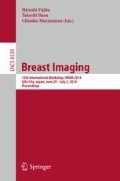Abstract
Minimising the mean glandular dose (MGD) received by the patient whilst maximising image contrast during mammographic imaging is of paramount importance due to the widespread use of the modality for screening, where subjects are for the most part healthy. The advent of digital mammography brought about a general reduction in MGD, however the introduction of tomosynthesis, particularly when used in combination with conventional projection mammography has the potential for unwanted and often unnecessary MGD increases. We describe a method to calculate the patient-specific MGD using a representation of the patient’s volumetric breast density to derive the breast glandularity. This personalises the MGD to the individual woman, rather than assuming a constant value, or one that depends solely on compressed breast thickness. The calculated patient specific MGDs are compared to those reported by the manufacturer for a database of 2D mammograms. Though agreement is generally good for dense breasts, we have found that the MGD is underestimated in fatty breasts. A separate database of 2D mammogram and 3D tomosynthesis acquisitions acquired in “combo” is also analysed. In general, the MGDs are approximately equal for dense (VDG 3 and 4) breasts, but fatty (VDG 1 and 2) breasts exhibited significant differences with tomosynthesis MGDs being higher than mammogram MGDs for these cases.
Access this chapter
Tax calculation will be finalised at checkout
Purchases are for personal use only
Preview
Unable to display preview. Download preview PDF.
References
The 2007 Recommendations of the International Commission on Radiological Protection. ICRP publication 103. Ann. ICRP 37(2-4), 1–332 (January 2007)
Hendrick, R.E., Pisano, E.D., Averbukh, A., Moran, C., Berns, E.A., Yaffe, M.J., Herman, B., Acharyya, S., Gatsonis, C.: Comparison of acquisition parameters and breast dose in digital mammography and screen-film mammography in the American College of Radiology Imaging Network digital mammographic imaging screening trial. AJR. Am. J. Roentgenol. 194(2), 362–369 (2010)
Dance, D.R., Skinner, C.L., Young, K.C., Beckett, J.R., Kotre, C.J.: Additional factors for the estimation of mean glandular breast dose using the UK mammography dosimetry protocol. Phys. Med. Biol. 45(11), 3225 (2000)
Dance, D.R., Young, K.C., van Engen, R.E.: Estimation of mean glandular dose for breast tomosynthesis: factors for use with the UK, European and IAEA breast dosimetry protocols. Phys. Med. Biol. 56(2), 453–471 (2011)
Dance, D.R., Thilander, A.K., Sandborg, M., Skinner, C.L., Castellano, I.A., Carlsson, G.A.: Influence of anode/filter material and tube potential on contrast, signal-to-noise ratio and average absorbed dose in mammography: a Monte Carlo study. Br. J. Radiol. 73(874), 1056–1067 (2000)
Dance, D.R., Young, K.C., van Engen, R.E.: Further factors for the estimation of mean glandular dose using the United Kingdom, European and IAEA breast dosimetry protocols. Phys. Med. Biol. 54(14), 4361–4372 (2009)
Dance, D.R.: Monte Carlo calculation of conversion factors for the estimation of mean glandular breast dose. Phys. Med. Biol. 35(9), 1211–1219 (1990)
Wu, X., Barnes, G.T., Tucker, D.M.: Spectral dependence of glandular tissue dose in screen-film mammography. Radiology 179(1), 143–148 (1991)
Sobol, W.T., Wu, X.: Parametrization of mammography normalized average glandular dose tables. Med. Phys. 24(4), 547–554 (1997)
Wu, X., Gingold, E.L., Barnes, G.T., Tucker, D.M.: Normalized average glandular dose in molybdenum target-rhodium filter and rhodium target-rhodium filter mammography. Radiology 193(1), 83–89 (1994)
Boone, J.M.: Glandular breast dose for monoenergetic and high-energy X-ray beams: Monte Carlo assessment. Radiology 213(1), 23–37 (1999)
Feng, S.S.J., Sechopoulos, I.: Clinical digital breast tomosynthesis system: dosimetric characterization. Radiology 263(1), 35–42 (2012)
Author information
Authors and Affiliations
Editor information
Editors and Affiliations
Rights and permissions
Copyright information
© 2014 Springer International Publishing Switzerland
About this paper
Cite this paper
Tromans, C.E. et al. (2014). Patient Specific Dose Calculation Using Volumetric Breast Density for Mammography and Tomosynthesis. In: Fujita, H., Hara, T., Muramatsu, C. (eds) Breast Imaging. IWDM 2014. Lecture Notes in Computer Science, vol 8539. Springer, Cham. https://doi.org/10.1007/978-3-319-07887-8_23
Download citation
DOI: https://doi.org/10.1007/978-3-319-07887-8_23
Publisher Name: Springer, Cham
Print ISBN: 978-3-319-07886-1
Online ISBN: 978-3-319-07887-8
eBook Packages: Computer ScienceComputer Science (R0)

